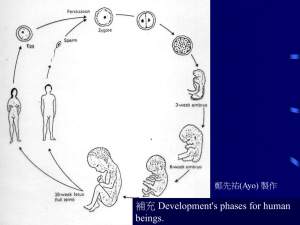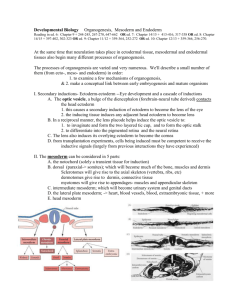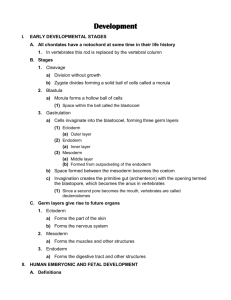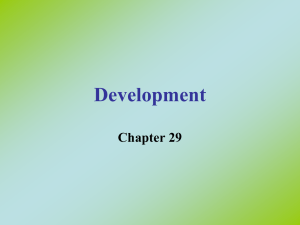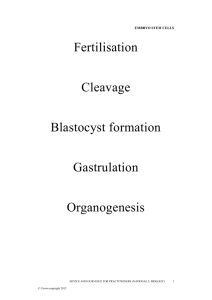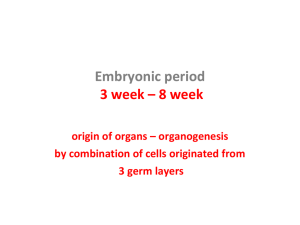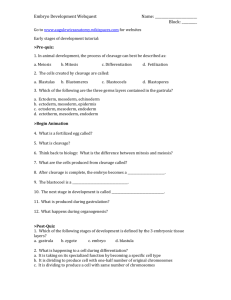Study Guide for Exam IV Paraxial and Intermediate Mesoderm
advertisement
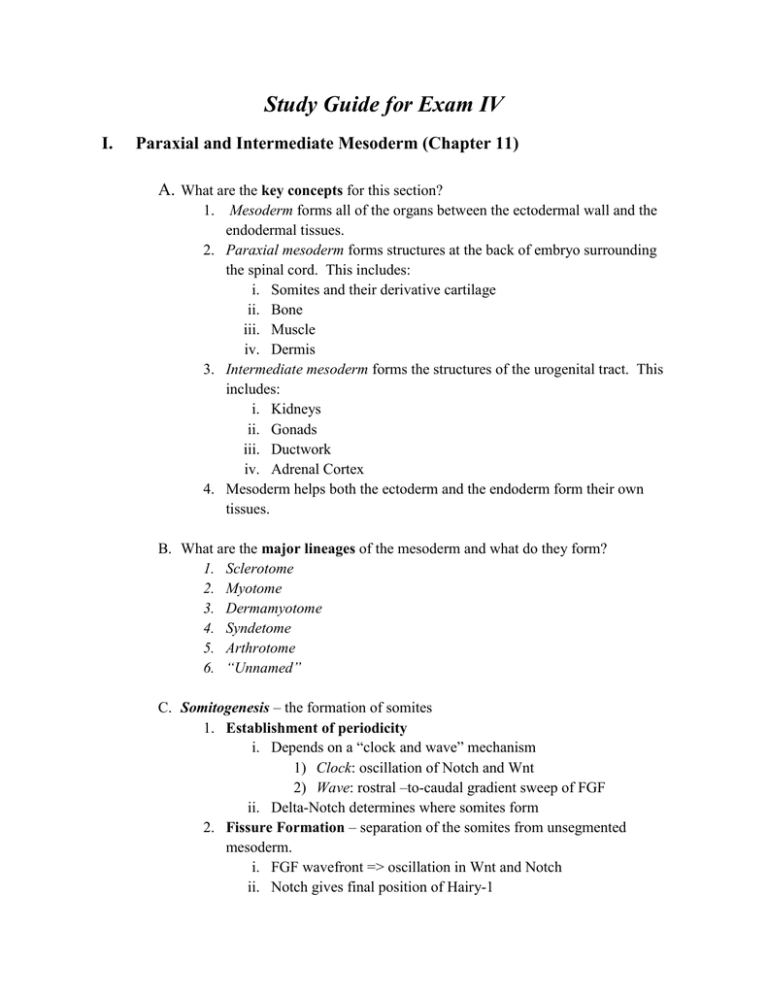
Study Guide for Exam IV I. Paraxial and Intermediate Mesoderm (Chapter 11) A. What are the key concepts for this section? 1. Mesoderm forms all of the organs between the ectodermal wall and the endodermal tissues. 2. Paraxial mesoderm forms structures at the back of embryo surrounding the spinal cord. This includes: i. Somites and their derivative cartilage ii. Bone iii. Muscle iv. Dermis 3. Intermediate mesoderm forms the structures of the urogenital tract. This includes: i. Kidneys ii. Gonads iii. Ductwork iv. Adrenal Cortex 4. Mesoderm helps both the ectoderm and the endoderm form their own tissues. B. What are the major lineages of the mesoderm and what do they form? 1. Sclerotome 2. Myotome 3. Dermamyotome 4. Syndetome 5. Arthrotome 6. “Unnamed” C. Somitogenesis – the formation of somites 1. Establishment of periodicity i. Depends on a “clock and wave” mechanism 1) Clock: oscillation of Notch and Wnt 2) Wave: rostral –to-caudal gradient sweep of FGF ii. Delta-Notch determines where somites form 2. Fissure Formation – separation of the somites from unsegmented mesoderm. i. FGF wavefront => oscillation in Wnt and Notch ii. Notch gives final position of Hairy-1 iii. Hairy-1 causes Ephrin expression which repels neighbors 3. Epitheliazation i. Occurs immediately after somitic fission ii. Peripheral somitic cells undergo MET 4. Specification i. Happens along the anterior-posterior axis ii. Occurs early due to Hox expression iii. Transplants form what they would have in original position 5. Differentiation i. The somite contains a population of multipotent cells whose specification depends of their location within the somite. ii. Step 1: Notochord induction of sclerotome iii. Step 2: Segregation of dermamyotome 1) Dermatome 2) Primaxial myotome 3) Abaxial myotome 4) Central myotome D. Mechanisms of Tissue Formation from Somites 1. Myogenesis- muscle formation i. Muscle cells come from two cell lineages in the somite: the primaxial and the abaxial. ii. Cells in the center give rise to satellite cells iii. Skeletal muscle differentiation 2. Osteogenesis- bone formation i. What are the four different sources of bone? 1) Somites from the axial skeleton 2) Lateral plate mesoderm form the limb skeleton 3) Cranial neural crest forms the bones of the face and head 4) Mesodermal mesenchyme in patella, periosteum ii. What are the two different processes? 1) Endochondrial ossification – the formation of cartilage tissue from aggregated mesenchymal cells and the subsequent replacement of cartilage tissue by bone a. occurs in the first two sources of bone 2) Intramembraneous ossification – the direct conversion of mesenchymal tissue into bone a. occurs in the second two sources 3. Vascular Replacement in the Dorsal Aorta 4. The Syndetome: Tendon Formation E. Intermediate Mesoderm 1. Generates the urogenital system- the kidneys, the gonads, and their respective duct systems. i. Steps of Kidney Formation 1) The first thing formed is the organizer, which is the pronephric duct 2) The organizer induces three major stages of kidney. The first two are transient; only the third and last persists as a functional kidney. a. Pronephros b. Mesonephros c. Metanephros II. Lateral Plate Mesoderm (Chapter 12) A. Know the following terminology 1. Somatopleure 2. Splanchnopleure 3. Coelom i. Pleural cavity ii. Pericardial cavity iii. Peritoneal cavity B. Heart Development 1. Heart is 1st organ to function in embryo and the circulatory system is the first functional system. i. Heart => arteries => capillaries => veins => heart 2. Embryo must switch from nutrient diffusion to active nutrient transport before it can get very big 3. What are the anatomical stages of heart development? i. Tube formation 1) “The heart field” a. Inflow tract b.Outflow tract 2) Formation of heart tube is linked to formation of gut tube 3) Heart Cell Biology ii. Looping 1) Converts the original anterior-posterior polarity of the heart tube into the right-left symmetry seen in the adult organism a. Left-right symmetry: Nodal and Pitx2 2) Looping requires: a. Cytoskeletal rearrangement b.Extracellular matrix remodel c. Asymmetric cell division iii. Chamber formation 1) Endocardial cushions form and fuse 2) Septa grow towards cushion a. Separate the two atria and the two ventricles 3) Valves form from myocardium a. Keep the blood from flowing back into the chamber it was just ejected from 4. Embryonic circulatory systems i. All of the blood must circulate outside of the embryo for oxygenation ii. Redirection of human blood flow at birth 5. Blood vessel development i. Key Concepts: 1) Vessels for independently of heart 2) They form for embryonic needs as much as adult 3) The vessels are constrained by evolution 4) The vessels adapt to the laws of fluid dynamics ii. What are the two processes? 1) Vasculogenesis – initial formation of blood vessels a. De novo differentiation of mesoderm into endothelium b.Followed by the endothelium recruiting smooth muscle cell coat c. Secondary vasculogenesis a. Proepicardial organ (PEO) 2) Angiogenesis – sprouting of blood vessels and remodeling of vascular beds a. Happens in response to blood flow and tissuederived recruitment signals b.Arteries and veins a. Common phenomenon for arteries and nerves to form together, less so for veins c. Lymphatic drainage forms from jugular vein a. Sprouts as lymphatic sacs by angiogenesis b. Continues to form secondary drainage system c. Major conduit for immune cells 6. Hematopoietic stem cells i. Sites 1) Splanchnic mesoderm of aorta-gonad-mesonephros (AGM) region in embryo 2) Hemogenic endothelium from: a. Sclerotome b.Many sites III. Endoderm (Chapter 12) A. Two major functions: 1. Induce formation of several mesodermal organs 2. Construct the linings of two tubes within the vertebrate body i. The Digestive Tube 1) The derivatives ii. The Respiratory Tube B. Development of the Endoderm 1. The cranial neural crest cells migrate through this endoderm and contribute component structures around them i. Pharynx 1) Pharyngeal pouches a. Endoderm plays a critical role in determining which pouches develop b.SHH from the endoderm appears to act as a survival factor, preventing apoptosis of the neural crests cells 2) Pharyngeal arches 2. Gut is regionally specified at a very early stage i. Gradients of retinoic acid and FGF signals pattern the endoderm ii. Anterior –Posterior specification of the gastrointestinal (GI) tract 1) Reciprocal induction a. Simultaneous Anterior-posterior specification of both endoderm and mesoderm b.SHH, Hox genes, BMPs, and FGF 3. Localized Wnt/B-Catenin and retinoic acid cause budding i. Mesoderm also induces liver bud C. The Extraembryonic Membranes 1. Adaption for development on dry land i. As the body starts to develop, epithelium expands to isolate the embryo within them 2. What are the four sets of membranes? i. Somatopleure forms: 1) Amnion a. Folds up to cover the embryo and keep it from drying out b.The cells of the amnion secrete water 2) Chorion a. Surrounds the entire embryo and controls gas exchange b.In birds and reptiles it lines shell c. In mammals it forms the placenta ii. Splanchnopleure forms: 1) Yolk sac a. Expands to surround yolk, even if you don’t have any 2) Allantios a. Creates a space for waste storage b.Bird and reptile eggs got to have it c. We don’t use it for waste, but it contributes to our umbilical cord IV. Development of the Tetrapod Limb (Chapter 13) A. Limbs show an amazing aspect of development 1. Similarities i. Architectural symmetry in all four limbs ii. Size symmetry in the opposite limb iii. Symmetry in growth rate and development 2. Differences i. Forelimb-Hindlimb: rostral-caudal asymmetry ii. Mirror imagery in opposite limbs: left-right asymmetry iii. Structural polarity in 3 axes per limb? 1) Proximal-distal, anterior-posterior, dorsal-ventral 3. Skeletal pattern formation i. Femur => tibia-fibula => metatarsals-tarsals ii. The pattern extends to muscles, tendons, cartilage, vessels, nerves iii. Deletion of limb bone elements by the deletion of paralogous hox genes 4. Molecular specification of the pattern i. “Morphogenetic rules” cross species ii. Axis formation is driven by specific molecules 1) Proximal-distal: FGF family 2) Anterior-posterior: SHH 3) Dorsal-ventral: Wnt7a (mostly) B. Formation of the limb bud 1. Specification of the “limb field” i. What is the “limb field”? 1) The region that contains all the cells capable of forming a limb a. Free limb b.Shoulder girdle c. Peribrachial flank tissue ii. Black ring of cells around limb field 1) Will not contribute to the limb unless the other cells are lost. 2. Emergence of the limb bud i. Bulge is due to proliferation and migration of somatic mesoderm for bone and abaxial myotome for muscle ii. All cells in “limb field” are competent for all limb cells 1) Parasite infestation splits the “limb field” C. What are the four dimensions pattern formation occurs in? 1. Proximal-distal axis i. As mesodermal mesenchyme forms the limb bud it tells overlying ectoderm to form Apical Ectodermal Ridge (AER) 1) Removal of AER ceases development of distal limb skeletal elements ii. The AER then directs changing limb development in nearby mesoderm called the Progress Zone (PZ) 2. Anterior-posterior axis i. The “Zone of Polarizing Activity” (ZPA) is a piece of mesoderm at the junction of the young limb bud and the body wall 1) When a ZPA is grafted to anterior limb bud mesoderm, duplicated digits emerge as a mirror image of the normal digits 2) The same thing happens when you build a ZPA by making cells express SHH a. Concentration and timing of SHH is critical b.The SHH pattern is made more intricate by response in the webbing c. Secondary BMP signal makes all digits different 3. Dorsal-ventral axis i. Knuckle vs. palm axis 1) Determined by overlying ectoderm a. Reverse the covering => reverse the pattern 4. Time D. Cell death and the formation of digits and joints 1. Cell death i. essential if our joints are to form and if our fingers are to become separate 1) The difference between a chicken’s foot and the webbed foot of a duck is the presence or absence of cell death between the digits a. Inhibition of cell death by inhibiting BMPS 2. Joints i. Movement and muscular force are required to form the joints ii. They are complex structures compose of: 1) Ligaments 2) Tendons 3) Fibrous capsule 4) Lubrication 5) Immune system
